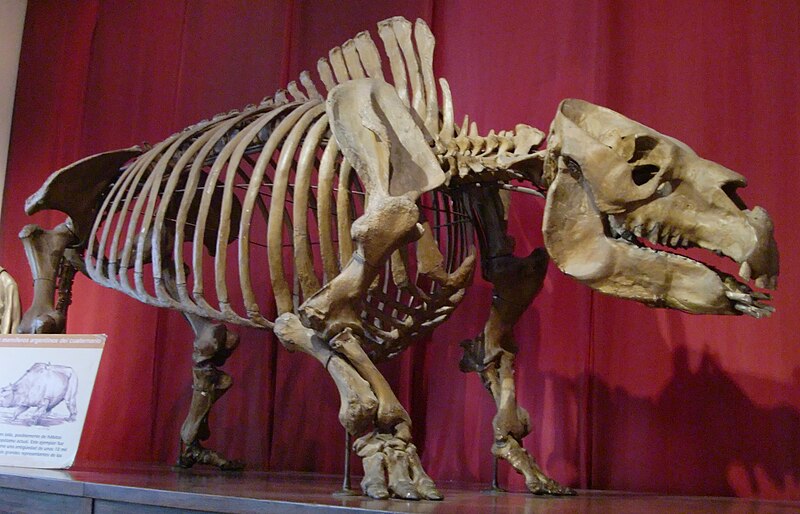Continues by
Megafauna Part I.....
6. Sarcosuchus imperator - The Super Croc
Sarcosuchus imperator, or “flesh crocodile emperor,” lived roughly 110 million years ago, when rivers coursed over what is now sub-Saharan Africa. Sarcosuchus prowled the rivers’ banks, crushing fish—and other creatures—in its massive jaws. The giant creature, which lived during the Middle Cretaceous, grew as long as 40 feet (12 meters) and weighed as much as eight metric tons (17,500 pounds). Growth lines were found in cross-sections of the armor plates--one line was laid down each year. A plate from an individual 80% grown had over 40 lines, so we suspect that a fully-grown individual would be at least 50-60 years old - about twice the longevity of living crocs. Its jaws alone were nearly six feet (1.8 meters) long and its more than 100 teeth so powerful that the colossal creature probably consumed small dinosaurs as well as fish, the researchers say.
7. C.Megalodon
Carcharocles megalodon (abbreviated to C.megalodon) was a huge prehistoric shark that lived between 25 and 1.5 million years ago (the Miocene and Pliocene epochs). It is now extinct but no one is sure when C.megalodon died out.
Two teeth of great white shark (white) compared to a single tooth of Megalodon (black). A coin 23 mm in width shows the scale.
We will probably never know for sure why Megalodon became extinct. But we can probably be grateful that it did: a 52-foot (16-metre) version of the White Shark with jaws large enough to engulf a rhino would almost certainly make recreational swimming or pleasure boating a LOT less enjoyable.
8. American lion
The American lion, also known as the North American or American cave lion, is an extinct feline known from fossils. It is comparable in size to the Eurasian cave lion, considered to be the second largest species of lion to have ever existed (after the cave lion), and was about 25% larger than the modern African lion.
The American lion averaged 3.5 m (11.5 ft) in length, with a typical male weighing about 235 kg (520 lb), and a typical female weighing about 175 kg (385 lb). It was comparable in size to its close relative the Eurasian cave lion, the modern Amur tiger and the hybrid liger, which is a hybrid that probably never occurs without human interference . They were still smaller than their contemporary, the short-faced bear, which is the largest carnivore of their era.
8. Toxodon
Toxodon was about 2.7 metres (8.9 ft) in body length, and about 1.5 metres (4.9 ft) high at the shoulder and resembled a heavy rhinoceros, with a hippopotamus-like head. Because of the position of its nasal openings, it is believed that Toxodon had a well developed snout. It had a massive skeleton, which suggests that it supported a large muscular body. It had short stout legs with three functional toes, with most of the body weight being borne by the central toe.
The vertebrae were equipped with high apophyses, which most likely supported the massive weight and muscles as well as its powerful head. Toxodon had broad jaws which were filled with bow shaped teeth and incisors. These teeth would have allowed the animal to tear through and bite off the plants and leaves.
9. Andrewsarchus mongoliensis
Andrewsarchus was a predatory ungulate (hoofed mammal) that lived during the late Eocene Epoch of the Cenozoic Era. This group constituted the only segment of the ungulates that was carnivorous, and the largest, andrewsarchus mongoliensis was the largest mammalian predator ever to walk on land. Oddly enough, andrewsarchus was most closely related to hippos and pigs rather than to more familiar groups of predators like big cats or dogs. Fossils of this giant have been uncovered in Central Asia, primarily Mongolia.

Extrapolating from the body proportions of similar mesonychids, such as Mesonyx, Andrewsarchus was probably about 4 metres (13 feet) long and may have stood nearly 2 metres (6 feet) at the shoulders. The cranium is about twice the length of an Alaskan brown bear (Ursus arctos middendorffi), but much narrower, and about triple the length of an Rocky Mountain wolf (Canis lupus occidentalis). Since the average brown bear weighs less than 1,000 pounds, and only an extreme specimen of a wolf weighs up to 77 kg (170 lb), we can only suggest, proportionately extrapolating body sizes, that Andrewsarchus probably weighed somewhere between 400 to 1,000 pounds at the most. But since we have only the skull, and no other fossil evidence, this is pure speculation.
10. Smilodon
Smilodon was the largest saber-toothed cat (or saber-toothed tiger). It was a fierce predator about 4-5 feet (1.2-1.5 m) long and 3 feet (0.9 m) tall. It weighed about 440 lbs (200 kg). It was a bit smaller than a modern-day lion (Panthera leo), but much heavier.
It had relatively short legs and a short, bobbed tail. Its front legs were especially powerful. Its body was adapted for springing onto prey, but it was not a very fast runner. Its 12-inch-long (30 cm) skull had 2 huge canine teeth. These saber-like teeth were serrated, oval in cross-section, and up to 7 inches (18 cm) long. Many Smilodon fossils have been found with broken canines; a fossil wolf was found with a Smilodon tooth fragment embedded in its skull. Smilodon had powerful jaws that opened to an angle of about 120°. Today's lions can only open their jaws 65°. Smilodon also had very strong jaw and neck muscles that let it stab prey with its deadly teeth.

Smilodon first appeared about 1.6 million years ago. This ferocious cat went extinct about 11,000 years ago. It lived during the last Ice Age, in which the Earth got much colder than it is now. Ice sheets and glaciers covered much of the land and sea levels fell as sea water froze into polar ice and glaciers. It lived during the Pleistocene Epoch (the early part of the Quaternary Period)




























































